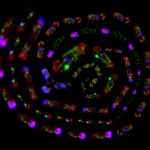Lien vers Pubmed [PMID] – 15647519
Mol. Biol. Evol. 2005 Apr;22(4):1011-23
Among genes conserved from bacteria to mammals are those involved in replicating and repairing DNA. Following the complete sequencing of four hemiascomycetous yeast species during the course of the Genolevures 2 project, we have studied the conservation of 106 genes involved in replication, repair, and recombination in Candida glabrata, Kluyveromyces lactis, Debaryomyces hansenii, and Yarrowia lipolytica and compared them with their Saccharomyces cerevisiae orthologues. We found that proteins belonging to the replication fork and to the nucleotide excision repair pathway were-on the average-more conserved than proteins involved in the checkpoint response to DNA damage or in meiotic recombination. The meiotic recombination proteins Spo11p and Mre11p-Rad50p, involved in making meiotic double-strand breaks (DSBs), are conserved as is Mus81p, involved in resolving meiotic recombination intermediates. Interestingly, genes found in organisms in which DSB-repair is required for proper synapsis during meiosis are also found in C. glabrata, K. lactis, and D. hansenii but not in Y. lipolytica, suggesting that two modes of meiotic recombination have been selected during evolution of the hemiascomycetous yeasts. In addition, we found that SGS1 and TOP1, respectively, a DEAD/DEAH helicase and a type I topoisomerase, are duplicated in C. glabrata and that SRS2, a helicase involved in homologous recombination, is tandemly duplicated in K. lactis. Phylogenetic analyses show that the duplicated SGS1 gene evolved faster than the original gene, probably leading to a specialization of function of the duplicated copy.

